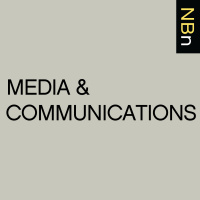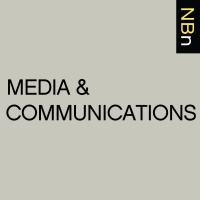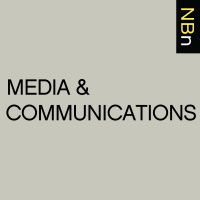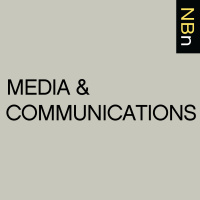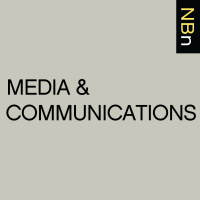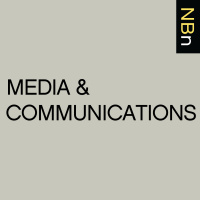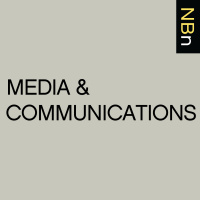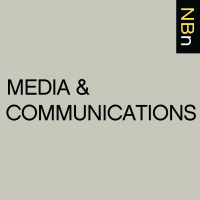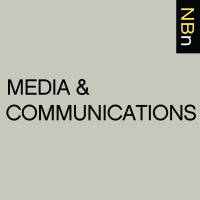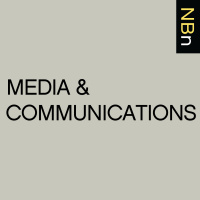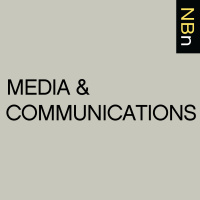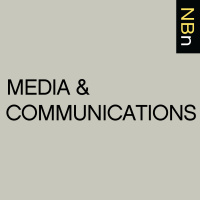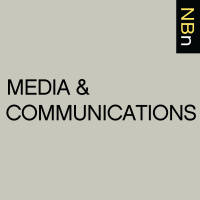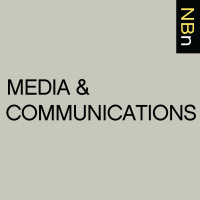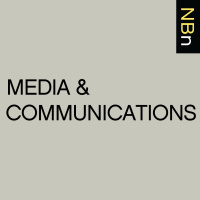Synopsis
Interviews with Scholars of Media and Communications about their New Books
Episodes
-
Jeffery Pomerantz, “Metadata” (MIT, 2015)
22/02/2016 Duration: 43minWhat is the “stuff” that fuels the information society in which we live? In his new book, Metadata (MIT 2015), information scientist Jeffrey Pomerantz asserts that metadata powers our digital society. After defining metadata-data that has the potential to provide information about an object-Pomerantz considers the various kind of metadata. This raw material provides descriptions about individuals and most every other thing in the world. This data allows people, places, and things to be found. According to Pomerantz, metadata has become infrastructural as it plays such a pivotal role about in all of the things we do, yet, it is invisible. This invisible foundational material is created and collected all the time, and has vast implications for governments, corporations, and individuals. Learn more about your ad choices. Visit megaphone.fm/adchoices
-
Finn Brunton, “Spam: A Shadow History of the Internet” (MIT Press, 2013)
16/02/2016 Duration: 59minFinn Brunton‘s Spam: A Shadow History of the Internet (MIT Press, 2013) is a cultural history of those communications that seek to capture our attention for the purposes of exploiting it. From pranks on early computer networks in the 1970s to commercial nuisances in the 1990s to the global criminal infrastructure of today driven by botnets and algorithms, spam’s history surfaces and shifts with the Internet itself. Spam is a lively book packed with tales of the people responsible for sharing and stopping spam’s myriad of forms in email, web sites and social networks. This includes everyone from programmers and security professionals, marketers and lawyers, and con artists and thieves to name a few. Each person has personal experiences with spam and opinions about when they’re being spammed, but Brunton, a professor at New York University, reminds us about the critical role that communities, organizations, and governments have played in regulating spam. Ultimately, the governance agreed to by these groups def
-
Barry Brown and Oskar Juhlin, “Enjoying Machines” (MIT 2015)
06/01/2016 Duration: 34minWhen we consider the television, we think not only about how it’s used, but also it’s impact on culture. The television, tv, telly, or tube, became popular in the West in the late 1940s and early 1950s and was seen as a form of entertainment and enjoyment for the family. Other “technology” that assists with leisure include things like rubber-soled shoes, books, and other digital devices. In their new book, Enjoying Machines (MIT 2015), Barry Brown and Oskar Juhlin, both scholars in the Stockholm University Mobile Life VINN Excellence Center, the success of a particular technology can be measured by how well it creates pleasure. The authors argue that pleasure “is fundamentally social in nature,” and that to understand how technology supports leisure it is important to “produce a more sophisticated definition” of enjoyment. To do this Brown and Juhlin embark on an ethnographic investigation of technology and enjoyment that combines the sociological study of activity and the study of human-machine interaction.
-
Peter J. Gloviczki, “Journalism and Memorialization in the Age of Social Media” (Palgrave MacMillan, 2015)
30/12/2015 Duration: 33minHumans have coped with tragedy using ritual and memorials since the Neolithic era. Doka called a memorial a space invested with meaning, “set aside to commemorate an event such as a tragedy.” Memorialization is a ritual of bereavement, the creation of a place, permanent or not, that facilitates the persistence of memory. This space allows for the restructuring of the social network between the living, those who create the memorial, and the dead, those for which the memorial is created. Memorialization happens in both the analog and digital contexts. In fact, some now decline to recognize a distinction between the on- and offline worlds. In his new book, Journalism and Memorialization in the Age of Social Media (Palgrave MacMillan, 2015), Peter J. Gloviczki, an assistant professor at Coker College, conceptualizes online memorials as networked remembrance spaces. These social media posts and groups are “immediate, interactive and public and they function across a great distance.” Online memorials are both user
-
Megan Prelinger, “Inside the Machine: Art and Invention in the Electronic Age” (Norton, 2015)
19/11/2015 Duration: 01h09minMegan Prelinger‘s beautiful new book brings together the histories of technology and visuality to ask the question, “What cultural history of electronics can be extrapolated from a close look at the associated graphic art?” Inside the Machine: Art and Invention in the Electronic Age (W. W. Norton, 2015) treats the commercial and advertising art of the mid-twentieth century as an archive to explore the social and cultural engagement with electronics technologies during a particularly vibrant moment for the American graphic commercial arts. Incorporating text and image as sources to be read, Prelinger’s book moves from the beginnings of FM technology and vacuum tubes, to televisions and quartz crystals, to transistors and circuit boards, to digital computing and into space. Of special interest is the attention Prelinger pays to to the importance of graphic designers and staff artists at major labs and research centers. The book models an innovative and inspiring way to read graphic images as historical document
-
Jerome Bourdon, “Histoire de la television sous de Gaulle” (Presses des Mines, 2014)
17/11/2015 Duration: 01h13sJerome de Bourdon‘s Histoire de la television sous de Gaulle (Presses des Mines, 2014) is a revised version of a book that first appeared in 1990. This edition has been revamped, and includes a new introduction in which Bourdon explores the historiography of the medium in the years since the book’s original publication. A history of television that is also a history of the De Gaulle presidency and the early years of the Fifth Republic, Histoire de la television sous de Gaulle examines a range of issues, from government legislation to programming and content, to the variety of personnel (directors, producers, technicians, administrators) who made television happen during this “era of professionalization.” Exploring the medium as both information and entertainment, the book considers the relationship between television and the cinema, situating television within the broader cultural and political history of France during this critical period. Covering key events and turning points, including the introduction of
-
John Durham Peters, “The Marvelous Clouds: Toward a Philosophy of Elemental Media” (U of Chicago Press, 2015)
17/11/2015 Duration: 01h04minJohn Durham Peters‘ wonderful new book is a brilliant and beautifully-written consideration of natural environments as subjects for media studies. Accessible and informative for a broad readership. The Marvelous Clouds: Toward a Philosophy of Elemental Media (University of Chicago Press, 2015) is structured as a series of meditations on and explorations of water, fire, air, earth, and ether media. After a chapter that sets out some of the foundational ideas shaping the book and charts an intellectual landscape for rethinking media, each of the following chapters offers a carefully curated series of studies of particulars – dolphin jaws, candles, towers, watches, clouds, feet, bells, weathermen, Google, and more – as a means of examining the significance of infrastructure, forgetting, technicity, and other modes of understanding media. Peters asks us to come with a fresh perspective to notions that we otherwise take for granted, and the result is a thoughtful and inspiring account that brings together media s
-
Eric T. Meyer and Ralph Schroeder, “Knowledge Machines: Digital Transformations of the Sciences and Humanities” (MIT Press, 2015)
15/11/2015 Duration: 38minBy now it is incontrovertible that new technology has had an effect on how regular people get information. Whether in the form of an online newspaper or a Google search, new technology has allowed individuals to access masses of information faster than ever before. What, then, has been the effect of digital tools on research practices? In their new book Knowledge Machines: Digital Transformations of the Sciences and Humanities (MIT Press, 2015), Eric T. Meyer, Associate Professor and Senior Research Fellow at the Oxford Internet Institute, and Ralph Schroeder, Professor at the Oxford Internet Institute, explore how digital tools have transformed research. To do this, Meyer and Schroeder use case studies to examine how new technology has, and continues to, change research in various fields, and what this means for the future of e-research. Learn more about your ad choices. Visit megaphone.fm/adchoices
-
Hilary Neroni, “The Subject of Torture: Psychoanalysis and Biopolitics in Television and Film” (Columbia UP, 2015)
27/10/2015 Duration: 01h22sDid you notice that after 9/11, the depiction of torture on prime-time television went up nearly seven hundred percent? Hilary Neroni did. She had just finished a book on the changing relationship between female characters and violence in narrative cinema, and was attuned to function of violence in film and television. This was around the time the Abu Ghraib torture photos were leaked to the public. Over the next 10 years, torture porn appeared in the Saw and Hostel films, and it seemed that torture quickly became a routine element of thriller plots in movies and TV, such as the series 24. In The Subject of Torture: Psychoanalysis and Biopolitics in Television and Film (Columbia University Press, 2015), Neroni makes a compelling case that, prior to 9/11, the stage had already been set for the dehumanizing fantasy of torture to appear in mass culture – via biopolitics. With this book, Neroni takes on the task of defining and understanding torture through a psychoanalytic lens, using films and television as ca
-
Joseph R. Dennis, “Writing, Publishing, and Reading Local Gazetteers in Imperial China, 1100-1700” (Harvard University Asia Center, 2015)
18/10/2015 Duration: 01h01minIn late imperial China, how did local elites connect with and influence the central government? How was local information made and managed? How did the state incorporate frontier areas into the empire? How were books produced and read, and by whom? In his new book, Joseph R. Dennis helps answer these questions and more by studying the genre of local gazetteers. Focusing on the Ming period, Writing, Publishing, and Reading Local Gazetteers in Imperial China, 1100-1700 (Harvard University Asia Center, 2015) argues that gazetteers were “important points of intersection between the central government and local societies and one of the main vehicles for transmitting local information to central government officials.” In seven chapters that collectively move readers through the life cycle of a gazetteer, Dennis’s story informs the histories of the frontier, the state, kinship, the law, material culture, and the book industry. It will be a must-read for all scholars and students of late imperial Chinese history. Lea
-
Gillian Isaacs Russell, “Screen Relations: The Limits of Computer-Mediated Psychoanalysis and Psychotherapy” (Karnac, 2015)
13/10/2015 Duration: 55minAt New Books in Psychoanalysis, interviews are conducted using Skype. As the program is audio rather than video based, it never occurred to me to use the camera on my computer to see on the screen the person I was speaking to. Rather, I kept my ear turned acutely towards the authors, hanging on their every word while privately perusing my list of questions. I have joked with many interviewees that for all I know they are in their pajamas or naked. Truth be told, I have had no interest in seeing the authors during the interview. There was and is something about having the experience that the listener has on hearing, rather than seeing, the interview that may play a role in creating a certain kind of intensity and intimacy. So it was not lost on me that for this particular interview with Gillian Isaacs Russell about a book that looks straightforwardly at the impact of technology on the therapeutic relationship, that we would not be making eye contact. Though we could, I requested that we not do so. And anyway,
-
Kate Pahl, “Materializing Literacies in Communities: The Uses of Literacy Revisited” (Bloomsbury, 2014)
06/10/2015 Duration: 37minLiterary practices are often associated with specific social groups in particular social settings. Kate Pahl‘s Materializing Literacies in Communities: The Uses of Literacy Revisited (Bloomsbury, 2014) challenges these assumptions by showing the varieties of literary practice in Rotherham, England. The book engages with the locally particular to draw out a variety of general findings, relevant to methodological reflection and material culture debates. The book draws on a wealth of projects from the AHRC funded Connected Communities programme, including Fishing as Wisdom, The Imagine Project, and Language as Talisman. The book represents an important intervention into how we understand community, literacy and identity. Learn more about your ad choices. Visit megaphone.fm/adchoices
-
Lawrence M. Friedman, “The Big Trial: Law as Public Spectacle” (UP of Kansas, 2015)
05/10/2015 Duration: 41minIn the first legal history course I took as an undergraduate, I read Lawrence M. Friedman‘s A History of American Law and American Law in the 20th Century and have been fascinated with the subject ever since. His most recent work, The Big Trial: Law as Public Spectacle (University Press of Kansas, 2015) combines the scintillating narrative style that he employs as the author of several mystery novels with the keen insights about law and society that he has revealed time and again in his numerous cornerstone works of legal scholarship. Per the book jacket, “The trial of O. J. Simpson was a sensation, avidly followed by millions of people, but it was also, in a sense, nothing new. One hundred years earlier the Lizzie Borden trial had held the nation in thrall. The names (and the crimes) may change, but the appeal is enduring–and why this is, how it works, and what it means are what Lawrence Friedman investigates in The Big Trial. What is it about these cases that captures the public imagination? Are the “head
-
Joseph M. Reagle, “Reading the Comments: Likers, Haters and Manipulators at the Bottom of the Web” (MIT Press, 2015)
02/10/2015 Duration: 32minWhat do we know about the individuals who make comments on online news stories, blogs, videos and other media? What kind of people take the time to post all manner of information and context to material created by others? Joseph M. Reagle, assistant professor of communication studies at Northeastern University and a faculty associate at Harvard University’s Berkman Center for Internet and Society, examines these online pontificators and provocateurs in his new book Reading the Comments: Likers, Haters and Manipulators at the Bottom of the Web (MIT Press, 2015). Reagle categorizes the different kinds of comments, thereby organizing the different kinds of commenters into groups. In addition, Reagle considers both the function and value of comments in society. Just listen. Learn more about your ad choices. Visit megaphone.fm/adchoices
-
Sonja D. Williams “Word Warrior: Richard Durham, Radio, and Freedom” (U of Illinois Press, 2015)
23/09/2015 Duration: 01h12minSonja D. Williams‘ book Word Warrior: Richard Durham, Radio, and Freedom (University of Illinois Press, 2015) connects its subject to some of the most important events and social movements of his time, including what we now call the Civil Rights Movement and the Great Migration. Durham’s life path, like that of many other African Americans born in the early part of the 20th century, goes from the Jim Crow South, to Chicago, where his family builds a solid middle-class existence founded on educational attainment and hard work. Durham’s writing career included poetry, newspapers, radio, television, and a celebrated biography of Muhammad Ali. Durham also played a significant role in the election of the first black mayor of Chicago, his high school friend, Harold Washington. In this engaging interview, Sonja Williams sheds important light on an unassuming man who was most comfortable quietly but forcefully serving the causes he believed in from behind the scenes. Learn more about your ad choices. Visit megaphone.
-
Nicole Starosielski, “The Undersea Network” (Duke UP, 2015)
25/08/2015 Duration: 01h09minNicole Starosielski‘s new book brings an environmental and ecological consciousness to the study of digital media and digital systems, and it is a must-read. The Undersea Network (Duke University Press, 2015) looks carefully and imaginatively at the geography of undersea cable networks, paying special attention to the materiality of network infrastructure and its relationships with the histories of the Pacific. The book revises what we think we know about the infrastructure of global networks: they are not “wireless,” but wired; not rhizomatic and distributed, but semicentralized; not deterritorialized, but “territorially entrenched”; not resilient, but precarious and vulnerable; and not urban, but rural and aquatic. After providing a broad overview of three major eras of cable development – the copper cables of the 1850s-1950s, the coaxial cables of the 1950s-1980s, and the fiber-optic cables of the 1990s on, in each case focusing on the importance of security, insulation, and interconnection – Starosielski
-
Randy Nichols, “The Video Game Business” (British Film Institute, 2014)
16/08/2015 Duration: 50minVideo games have become an important cultural and economic force in our media environment. In his new book, The Video Game Business (British Film Institute, 2014), scholar Randy Nichols provides an overview of the increasingly diverse global market for video games. Nichols locates the origins of the video game industry back to the dawn of the computer age in the 1960s. He then explores the emergence of an industry around video games, noting the interdependence of hardware and software across a number of key “epochs”: from consoles to computer gaming to the explosion of mobile gaming. Throughout the book, Nichols explores key moments of transition in video games by providing institutional profiles of key industrial players in the industry. His critical analysis of power in the video game industry also explores the role of labor and audiences. Learn more about your ad choices. Visit megaphone.fm/adchoices
-
Christopher Vitale, “Networkologies: A Philosophy of Networks for a Hyperconnected Age” (Zero Books, 2014)
12/08/2015 Duration: 43minNetworks seem to be the dominant metaphor for contemporary society. In Networkologies: A Philosophy of Networks for a Hyperconnected Age (Zero Books, 2014), Christopher Vitale sets out a manifesto for understanding and using networks as the basis of a new philosophy. The book draws on continental philosophy, complex systems theory and a range of other elements to both introduce and contextualise, as well as present, the networkology manifesto. The book explores what networks are, how they emerge, how they change and how they are resilient (or not). The book intervenes in the contemporary interest in networks and will thus be of interest beyond just the critical theoretical disciplines. The text is also part of a much broader networkological project, including an original iteration of the manifesto and several papers. You can find out more about the project here. Learn more about your ad choices. Visit megaphone.fm/adchoices
-
Michael Ray FitzGerald, “Native Americans on Network TV: Stereotypes, Myths, and the ‘Good Indian'” (Rowman and Littlefield, 2013)
24/07/2015 Duration: 54minIn his new book Native Americans on Network TV: Stereotypes, Myths, and the ‘Good Indian’ (Rowman and Littlefield, 2013), Michael Ray FitzGerald reviews how television represented Native Americans, including in both positive and negative stereotypes. He talks about these portrayals from early television shows to more recent characterizations. Learn more about your ad choices. Visit megaphone.fm/adchoices
-
Jonathan Coopersmith, “Faxed: The Rise and Fall of the Fax Machine” (Johns Hopkins UP, 2015)
17/07/2015 Duration: 01h02minJonathan Coopersmith‘s new book takes readers through the century-and-a-half-long history of the fax machine and the technologies that shaped and were shaped by it, from Alexander Bain’s 1843 patent to the computer-based faxing of the end of the 20thcentury. Faxed: The Rise and Fall of the Fax Machine (Johns Hopkins University Press, 2015) chronicles the transformations of fax wrought by a range of industries and technologies in the context of world wars and global economic changes. In Coopersmith’s able hands, the history of the fax machine substantively informs a number of fields and disciplines that might not seem immediately related to it: these include visual studies (as newspapers and the military helped drive the development of fax markets and technology thanks to the need for rapid transfer of images in times of war and beyond) and East Asian studies (as fax machines can be traced through the history of modern homes and businesses in Japan). Coopersmith tells a story of fax as a story of repeated fail

